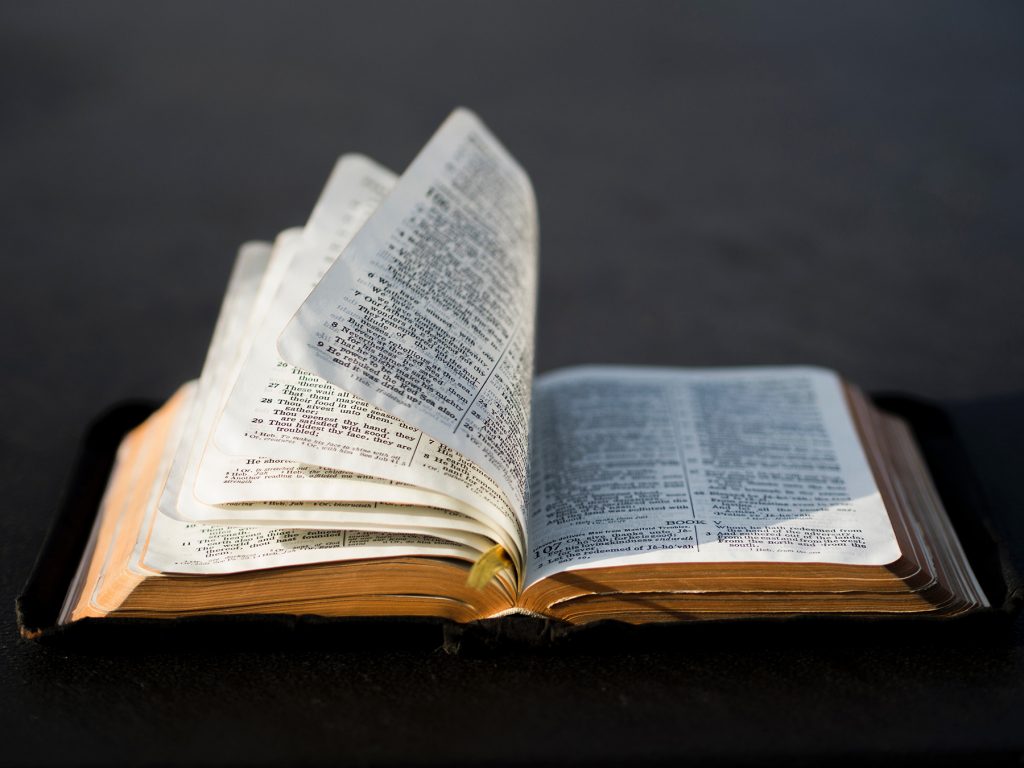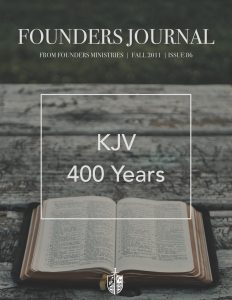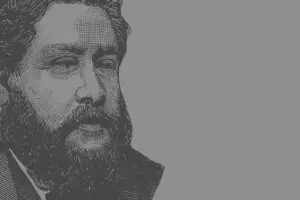This article was published in The Banner of Truth magazine, issue 572 (June 2011). Reprinted by permission.
“Translation it is that openeth the window, to let in the light; that breaketh the shell, that we may eat the kernel; that putteth aside the curtain, that we may look into the most holy place; that removeth the cover of the well, that we may come by the water ” –Miles Smith[2]
The sixteenth century was one of the great eras of English Bible translation. Between 1526, when William Tyndale’s superlative rendition of the New Testament was printed, and 1611, when the King James Bible (KJB), or Authorized Bible, appeared, no less than ten English-language Bible versions were published.[3] The translators of the KJB were quite conscious of their deep indebtedness to this beehive of translation activity that preceded their work. As they noted in the “Preface” of the KJB, drawn up by the Puritan Miles Smith (1554-1624), who had been among those responsible for the translation of the Old Testament prophets and who had also taken part in the final revision of the entirety of the Old Testament, they had not sought to “make a new translation.” Rather, it had been their “endeavour” or “mark” to “make a good one better, or out of many good ones, one principal good one.”[4] And of those many good versions that preceded the KJB, two especially deserve mention in any sketch of the history of the KJB: Tyndale’s New Testament and the Geneva Bible.
William Tyndale and his duty
“Widely acknowledged as the most formative influence on the text of the King James Bible,”[5] the New Testament of William Tyndale (c.1494-1536) comprises some four-fifths of the KJB New Testament.[6] Tyndale’s deep-rooted conviction, formed by the early 1520s, that the Scriptures were essential to the reformation of the Church in England had led him ultimately to Germany, where he found a competent die-cutter and printer, Peter Schöffer the younger, to publish his newly-translated New Testament in 1526 at his print-shop in Worms. Schöffer initially ran off a print-run of either three or six thousand copies.[7] The seven hundred or so pages of text of this New Testament was in a black-letter or Gothic font and printed in a compact octavo format, clearly designed to be carried with ease. There were no verse divisions, which did not come into vogue until the Geneva New Testament of 1557, but only simple chapter breaks. It was devoid of prologue and marginal notes, both of which would be found in later editions of the Tyndale New Testament and other later Tudor Bibles. Only three copies survive today: an imperfect one in the library of St. Paul’s Cathedral that is lacking the first seventy-one leaves; a copy that was owned by Bristol Baptist College, the oldest Baptist seminary in the world, since the mid-eighteenth century and that was sold in 1994 to the British Library for over a million pounds to be the centre-piece of an celebratory exhibit on the life of Tyndale; and a third copy recently discovered in the Landesbibliothek in Stuttgart, Germany.[8]
As Henry Wansbrough has noted, Tyndale’s translation is “a staggering achievement,” for he translated the entirety of the Greek New Testament into English, without any access to other similar English-language translations, for there were none.[9] However, when Tyndale’s version appeared in England, it received vitriolic criticism by such literary and ecclesial figures as Thomas More (1478-1535) and Cuthbert Tunstall (1474-1559), the Bishop of London, who said that it was “naughtily translated.”[10] More, for example, criticized Tyndale for translating presbuvstero” by the term “elder” or “senior” instead of “priest” and for rendering ejkklhsiva as “congregation” and not “church.” The English term “priest” actually derives from the Greek presbuvstero” and is therefore not at all a translation of the Greek word. Moreover, embedded in it is the idea of one who performs sacrifice, which is hardly an associated idea of presbuvstero” As for the use of congregation instead of church as a translation of ejkklhsiva, the latter had become solely a technical term in ecclesiastical jargon, which was hardly the case with regard to ejkklhsiva the New Testament era.[11] Moreover, Tyndale was also following the example of Desiderius Erasmus (1466-1536), a friend of both Tunstall and More, who sometimes rendered ejkklhsiva as congregatio in his own Latin rendition of the Greek New Testament he prepared to accompany his editions of the Greek text from 1516 onwards.[12]
Today it is clear that Tyndale had a solid handle on the Greek language, its grammar and idioms, shades of meaning and idiosyncrasies. A further example of his knowledge of Greek is found in Philemon 7, which Tyndale rightly translates, “For by thee (brother) the saints’ hearts are comforted.”[13] The KJB translators later rendered this verse as “the bowels of the saints are refreshed by thee, brother,” taking the Greek word splavgcna literally as “bowels.” But Tyndale rightly recognized that splavgcna is a metaphor for “heart” and thus should not be translated literally.
Equally important was Tyndale’s impressive grasp of the words and rhythms of the spoken English of his day. He knew how to render the Scriptures into the English vernacular so that they spoke with verve and power. In fact, as David Daniell notes, what strikes a present-day reader is how modern Tyndale’s translation seems.[14] For instance, in contrast to the KJB rendering of Romans 5:2–“we have access by faith”–Tyndale has the much more modern sounding “we have a way in through faith.”[15] “It is a sure thing” (Philippians 3:1)[16] is far more contemporary an expression than “it is safe” (KJB). Or consider his punchy version of 2 Kings 4:28–he began to work on the Old Testament in early 1530s–“thou shouldest not bring me in a fool’s paradise.” The KJB version is quite sedate in comparison, “do not deceive me.”[17]
In 1528 Tyndale allowed his name to appear in print for the first time with the publication in Antwerp of his exposition of Luke 16:1-12, The Parable of the Wicked Mammon.[18] In his prologue “To the Reader” Tyndale noted that some people asked him why he had bothered writing the book since his Roman Catholic opponents would burn it, “seeing they burnt the gospel [that is, the New Testament],” a reference to the burning of a significant quantity of the 1526 Worms New Testament at Cuthbert Tunstall’s behest. Tyndale’s response takes us to the very heart of his understanding of his calling to be a translator: “In burning the new Testament they did none other thing than that I looked for: no more shall they do, if they burn me also, if it be God’s will it shall so be. Nevertheless, in translating the New Testament I did my duty ”[19]
The impact of Tyndale’s doing his duty is well seen in an event that took place nearly thirty years after he wrote these words. One of his friends, John Rogers (1500-1555), who played the central role in the 1537 publication of “Matthew’s Bible” that included much of Tyndale’s translation work, was on trial for heresy. It was during the reign of Mary I (1516-1558), known to history as “bloody Mary” because of her brutal execution of nearly three hundred Protestants in a misguided attempt to take the evangelical Church of England back to Rome.[20] Rogers’ case was being heard by Stephen Gardiner (d.1555), Mary I’s Lord Chancellor. At one point, Gardiner told Rogers: “thou canst prove nothing by the Scripture, the Scripture is dead: it must have a lively [i.e. living] expositor.” “No,” Rogers replied, “the Scripture is alive.”[21] Undoubtedly Rogers is thinking of Hebrews 4:12, but his conviction is also rooted in the fact that Tyndale’s rendering of the Scriptures in “English plain style”[22] had played a key role, by God’s grace, in the Scriptures becoming a vehicle of life-changing power among the English people.[23]
The Geneva Bible
During the Marian reign of terror, about a thousand English and Scottish Protestants fled to the European continent, and found places of refuge in Reformed locales like Zurich and Geneva. At this time Geneva was a major centre of biblical scholarship with more than thirty publishing houses. In the 1550s alone these publishers printed new editions of both the Hebrew and Greek Scriptures, supervised at least eight printings of the French Bible and translations of the Scriptures into Italian and Spanish.[24] It is not at all surprising that in such a climate the English and Scottish exiles began to plan a new translation of the Bible in 1556 that would eventually be published four years later and that would come to be known as the Geneva Bible. Like all of the English Bibles of this era, except for that of Tyndale, it was the joint product of a group of scholars.
The main translator and editor appears to have been William Whittingham (c.1524-1579), a fellow of All Souls College, Oxford, who was one of the most competent Greek linguists of the day and also fluent in both French and German.[25] Among the sources that Whittingham used was the 1553 edition of the French Bible of Pierre Olivétain (1506-1538), whose New Testament had been corrected by Olivétain’s cousin, the great Reformer John Calvin (1509-1564).[26] It is not clear whether Whittingham was responsible for the translation of the Old Testament. What is certain, according to David Daniell, is that the Geneva Bible’s Old Testament has a “wonderful richness” and “Britain was truly blessed in the men who made it.”[27]
Along with its superb translation of the Old and New Testaments, the Geneva Bible contained a running commentary on the whole Bible in the form of marginal notes, what Patrick Collinson has called a “portable library of divinity.”[28] As shall be seen, some of these marginal notes would infuriate King James I and bias him against this version. The majority of the notes contain helpful explanations of the text. Occasionally there is exhortation and application. For example, with regard to Genesis 24:58 (“And they called Rebekah and said unto her, Wilt thou go with this man?”), the marginal note commented: “This sheweth that parents have not authoritie to marry their children without consent of the parties.” Contrary to an impression transmitted among some historians of the English Bible,[29] no more than ten of the original marginal notes, outside of the Book of Revelation, were barbed attacks on other religious perspectives of that era, notably that of the Roman Catholic Church. The marginal notes to the book of Revelation, however, do contain a significant amount of apocalyptic speculation some of which explicitly targets the Roman Church and the Papacy.[30] For example, the sternest marginal note in this regard is an explanation of the judgment of painful sores in Revelation 16:2. The note likens this judgment to that of the sixth plague of Egypt and that which “reigneth commonly among canons, monks, friars, nuns, priests, and such filthy vermin which bear the mark of the beast.” This is strong stuff, but, as Daniell comments, its tone is not the norm even among the apocalyptic notes on Revelation.[31]
With the death of Queen Mary in 1558 and the accession of her half-sister Elizabeth to the throne–“our Deborah” and “our Judith,” as Edwin Sandys (1519-1588), one of the Marian exiles and a translator of the Bishops’ Bible, called her[32] –there was no longer any doubt that England and Wales were firmly in the Protestant orbit. The question that now came to the fore, though, was to what extent the Elizabethan church would be reformed. By the 1560s it was evident that Elizabeth was content with a church that was something of a hybrid: committed to Reformation truth but tolerating a variety of things in its worship that were left over from the Middle Ages for which there was no biblical sanction.[33]
It was as a response to this situation that the Puritans, many of them Marian exiles, emerged in the 1560s. Their expressed goal was to reform the Elizabethan church after the model of the churches in Protestant Switzerland, in particular those in Geneva and Zürich. And their Bible was the Geneva Bible. It was, in part, because of this identification of the Geneva Bible with the Puritan party that the episcopal establishment promoted a new translation, the Bishops’ Bible, which saw the light of day in 1568. Though accurate in much of its rendering of the Hebrew and Greek, the Bible was a massive disappointment. Derek Wilson explains: the Bible was “rendered in stiff, cold English. It lacked the fluidity, the warmth of the version which the close-knit group of exiles had infused into the Geneva Bible.”[34]
The failure of the Bishops’ Bible to replace the popularity of the Geneva Bible is well seen by comparing the number of editions of these two Bibles. Between 1560 and 1611, there over 120 editions of the Geneva Bible, with an edition every year from 1575 to 1618 (seven years after the appearance of the King James Bible). By comparison there were only twenty-two editions of the Bishops’ Bible between 1568 and 1611.[35] It is noteworthy that it was the Geneva Bible that was the Bible of that premier Elizabethan and Jacobean word-smith, William Shakespeare (1564-1616), not the Bishops’ Bible.
A Puritan proposal of a new translation
The accession of James VI (1566-1625) of Scotland to the English throne as James I was greeted by the Puritans with a deep measure of joyful expectation, for James had been raised within the bosom of the Church of Scotland, one of the most Reformed bodies in Europe. They wrongly assumed that a man with such a pedigree would be amenable to their theological and liturgical concerns, which were quite similar to those of their Scottish brethren. They were wrong. James was imbued with a deeply-rooted conviction of the divine right of kings, namely, that the monarch derives his political legitimacy from God alone and therefore cannot be held accountable by any earthly authority. As such he found the fundamental hierarchical arrangement of the episcopal Church of England much more to his liking than the more egalitarian presbyterianism of Scotland, which was far more difficult for a monarch with James’ convictions to control.[36] As James said early on in his reign in England, presbyterianism “agreeth as well with a monarchy as God and the devil”![37] Nevertheless, when James was presented with a list of Puritan grievances in what has come to be called the Millenary Petition (1603) at the very outset of his reign, he agreed to listen to them at a duly-called conference at Hampton Court near London in January, 1604.[38]
Four moderate Puritans were invited to present the concerns of their fellows to the king: John Rainolds (1549-1607), president of Corpus Christi College, Oxford, who acted as the spokesman; Laurence Chaderton (1537-1640), master of Emmanuel College, Cambridge, a distinguished Hebraist and Greek scholar and also one of the great preachers of that era;[39] John Knewstubs (1544-1624), a Suffolk rector and Thomas Sparke (1548-1616), a minister from Lincolnshire. Also invited to the conference, which stretched over five days, from Saturday, January 14 to Wednesday, January 18, were nine bishops of the Church of England, including Richard Bancroft (1544-1610), the Bishop of London who became the Archbishop of Canterbury a couple of months later, and seven deans, one of whom was the famous Lancelot Andrewes (1555-1626), whose mastery of fifteen languages and a wealth of theological and ecclesiastical knowledge rightly earned him the reputation of being one of the most learned men in England. Andrewes would be among the KJB translators.
It needs noting that some of the bishops were actually good friends of their Puritan counterparts. Rainolds’ oldest friend was there the first day of the conference, Henry Robinson (c.1553-1616), the Bishop of Carlisle, an evangelical Calvinist like Rainolds and the other Puritans. As Adam Nicolson has rightly noted, “there was more uniting these [two] men than dividing them.”[40] Chaderton and Knewstubs used to regularly spend time with Andrewes when the three of them were students at Cambridge, and Chaderton was actually at one time Bancroft’s best friend, though the latter was now rabidly opposed to the Puritanism represented by Chaderton.[41] In total, there were eighteen adversaries of the Puritan party at the conference. The odds were clearly stacked in favour of the episcopal opposition to the Puritans and, in the final analysis, none of the Puritans’ concerns were really addressed. Although the king’s dealings with the bishops could hardly be called mild, he was sternness itself with the Puritans. He later said that he had “peppered them” and forced them so to flee “from argument to argument” that none of them could answer him directly.[42] The total failure of the conference from the point of view of the Puritans led to the radicalization of certain figures in the movement, who became committed to congregationalism, despairing of any hope of further magisterial reform.[43]
It was on the second day of the conference, Monday, January 16, as the mid-winter sun was going down in the afternoon, that Rainolds proposed that there be “one only translation of the Bible to be authentic and read in the churches.”[44] This seems a surprising proposal, coming as it did from a Puritan who would have been expected to have been content with the Geneva Bible, so beloved of the Puritan party. Adam Nicolson plausibly suggests Rainolds might have had in mind a revision of the Bishops’ Bible, which Elizabeth I, had promoted as the official Bible of the English church, and which, despite the sumptuousness of its printed appearance, had never been popular with either the people or the Puritans, as already noted. Moreover, it was undoubtedly the poorest translation overall of the Tudor Bibles.[45] On the other hand, David Daniell, followed by Derek Wilson, believes that Rainolds was thinking of the advances that had been made in Hebrew and Greek scholarship over the fifty years that lay between his proposal and the publication of the Geneva Bible and that this alone necessitated a new work.[46]
Whatever Rainolds’ motivation, James leapt upon the new proposal with zest, for he despised the Puritans’ Geneva Bible. This had been the version that his redoubtable tutor, George Buchanan (1506-1582), had drilled into him when he was a young boy.[47] It was also this version that was favoured by the Scottish presbytery, of whom James was not enamoured, as has been seen.[48] At a number of places this translation challenged his concept of an absolute monarchy. The word “tyrant,” for instance, appeared around thirty times in the 1599 edition of the Geneva Bible. It is not found even once in the version that James will authorize.[49] Then, in the notes accompanying the text of Exodus 1, the midwives are commended for their disobedience of Pharaoh’s command to kill the newborn Hebrew males at birth. “Their disobedience herein was lawful,” the note to verse 19 read, though their lying to Pharaoh to cover up their disobedience was plainly designated as “evil.” It should occasion no surprise that, in the list of guidelines for the new translation James would specify that “no marginal notes at all [were] to be affixed” to the text except those that were absolutely necessary for the explanation of the underlying Hebrew or Greek.[50]
Translating for King James
In the days following the Hampton Court Conference, six panels of translators were appointed: two to work at Westminster on Genesis through to
2 Kings and on the letters of the New Testament; two at Cambridge University on 1 Chronicles to the Song of Songs and on the Apocrypha; and two at Oxford University translating the prophets as well as the Gospels, Acts and Revelation. There is no scholarly consensus about the total number of those involved first in translating and then in editing and revising. Of scholars writing recently on the history of the KJB, Alister McGrath lists forty-seven actual translators, while Gordon Campbell’s list, which includes those involved in the later stages of revision, comes in at fifty-seven.[51] Of these, there were only half a dozen or so, including Rainolds and Chaderton, who were clearly Puritan in their sympathies. Moreover, they were, for the most part, seasoned scholars. In the words of Gordon Campbell, “the learning embodied in the men of these six companies is daunting.”[52]
James actually wanted the Bishops’ Bible retained as the standard, and the new translation more of a revision than actual translation. The royal printer, Robert Barker (d.1645), thus provided forty copies of the 1602 printing of the Bishops’ Bible for the use of the translators.[53] As it turned out, though, the KJB was very much a fresh translation with the major literary influence, as has been observed, being that of Tyndale and not the Bishops’ Bible.
Each of the six companies worked separately at first on the portion of the Bible assigned to it. Historians have only the sparsest of details about exactly how the translators carried out their work–it is still quite “mysterious,” is the way that David Norton puts it.[54] Part of the evidence about the work of translation is a list of fifteen instructions drawn up by Bancroft as essential guidelines for the six companies. The close use of the Bishops’ Bible as an exemplar was the first of these instructions, although the fourteenth directive allowed the translators to look at other earlier translations, including Tyndale’s and the Geneva Bible. There is every indication that the other instructions were also carefully observed.[55] For instance, Bancroft had instructed the translators to keep “the old ecclesiastical words,” so that “the word church” was “not to be translated congregation.” This is obviously a rejection of Tyndale’s preferred way of translating ejkklhsiva. As a result, although the word congregation is frequently used for the people of God in the Old Testament, it is never used for the church in the New Testament.[56] But observance of this instruction was also a way of rejecting some elements of Puritan theology, as Miles Smith’s “Preface” noted: “we have avoided the scrupulosity of the Puritans, who leave the old ecclesiastical words, and betake them to other, as when they put washing for baptism and congregation instead of church.”[57]
Work on the translation had definitely begun by August 1604, and all of the companies seemed to have completed their assignments by 1608. These initial drafts were then vetted in 1610 over a period of nine months by a special review committee of between six and twelve men that met in London. We know the names of only three, possibly four, of the individuals on this review committee.[58] One of them was John Bois (1560-1643), a former fellow of St. John’s College, Cambridge, whose notes from the discussions of the committee of revisers are the only ones extant and which will be discussed in more detail below.[59] The work of this committee then went through the hands of two more men, one of whom was Miles Smith, who wrote the “Preface” to the KJB. Finally it was looked over by Archbishop Bancroft. So, towards the close of 1610, the manuscript was given to the royal printer, Robert Barker, to print.[60]
John Bois’ notebooks
A fascinating glimpse into the mechanics of the revision committee is provided by the notes of John Bois, which were long thought lost, but two copies of which have been discovered by Ward Allen and David Norton in 1969 and 1996 respectively.[61] Bois had been reading Greek and Hebrew from the age of at least six, having been tutored by his father. Not surprisingly, by the time that he studied at Cambridge his knowledge of the biblical languages was extensive. After he married in 1596, he resigned his fellowship and took a small country parsonage in the village of Boxworth, eight miles north-west of Cambridge. He would ride over to Cambridge each week to work with the committee assigned the translation of the Apocrypha. And later, when the revision committee was assembled in 1610, Bois was asked to serve on it. Up to this point neither he nor any of his fellow translators had received any financial remuneration for their labours, but during the course of the nine months that Bois was in London, he, along with the other members of the revision committee, was given thirty shillings per week.[62]
Bois’ notes, taken down during the course of daily meetings, reveal the revisers discussing the various shades of meaning a word can have, making grammatical points and debating them, sometimes with great vehemence, but always striving to find translations acceptable to the majority of the committee. Few of the suggested translations in the notes appear to have made it into the 1611 KJB. One that did was Bois’ suggestion at 2 Corinthians 7:1 that the Greek ejpitelou`nte” aJgiwsuvnhn should be translated as “perfecting holynesse.”[63] Another of Bois’ suggestions that was adopted at this revision stage was the phrase “being knit together in love” from Colossians 2:2.[64] Often, though, Bois’ wordings were passed up in favour of another, better rendering. When, at Titus 2:10, Bois wanted “no filchers,” an Elizabethan slang term for a petty thief, the committee stuck with “not purloining”–both equally obscure words for today’s reader.[65]
On occasion Bois included the suggestions of the other revisers. For example, Bois notes that Andrew Downes (c.1549-1628), who had been his Greek tutor at Cambridge and who had been quite reluctant to spend nine months in the English capital, remarked that if the words about Christ in Hebrews 13:8 were arranged in this manner “yesterday, and today the same, and for ever,” then “the statement will seem more majestic.”[66] His fellow committee members, though, went with “the same yesterday, and to day, and for ever.” Adam Nicolson rightly observes that Downes’ remark about the phrase appearing more “majestic” reveals a key aspect of the translation that the revisers wanted it to have beyond fidelity to the original and clarity, and that is majesty and grandeur of style.[67]
The initial reception of the KJB
The early printings of the KJB, David Norton observes, were challenging for the printer Robert Barker since he was under considerable pressure “to produce as much as possible as fast as possible.”[68] Thus, early print-runs were marred by a variety of typographical errors, of which the most famous was probably the “Wicked Bible” (1631), so named because the word “not” was omitted from the seventh commandment of the Decalogue (Exodus 20:14), turning it into a positive admonition: “Thou shalt commit adultery.”[69] A close runner-up to this typo has to be the one that occurred in a 1612 printing, the first octavo edition. Where the Psalmist says, “Princes have persecuted me without a cause” (119:161), this edition reads, “Printers have persecuted me without a cause.” Norton thinks this must have been an “error” deliberately introduced into the text by a disgruntled employee in Barker’s workshop![70]
Despite such typos as these the episcopal establishment enthusiastically supported the new translation. They hoped it would help stem the tide of radical Puritanism and promote ecclesial unity.[71] The Puritan wing of the Church of England were not so enthusiastic, and they continued to support the printing of the Geneva Bible, the last edition of which rolled off the press as late as 1644. It would not be until the early pastoral ministry of the Puritan John Bunyan (1628-1688) in the late 1650s that the KJB would begin to shake the hold of the Geneva Bible over the English Puritan community. In fact, it is fascinating to find a spiritual descendant of these Puritans, a London Baptist by the name of Richard Hall (1729-1801), using a 1578 edition of the Geneva Bible as the family Bible in the mid-eighteenth century.[72] The Geneva Bible long retained its hold on the mindset of those committed to religious radicalism.
The severest critic of the KJB, though, has to have been Hugh Broughton (1549-1612), possibly the most distinguished Hebraist in Europe and who expected to have been among the translators of the KJB but was passed over, probably because of his combative spirit and violent temper. In the 1590s Broughton had tried without success to convince the Archbishop of Canterbury, then John Whitgift (c.1530-1604), to establish a committee of six scholars, including himself, to revise the English Bible.[73] He was sent a copy of the KJB almost as soon as it came off the press with the hope that he would give it a positive commendation. Vain hope! His response was a blistering eight-page pamphlet, which pointed out some of the faults of the new translation and which began thus:
The late Bible was sent to me to censure: which bred in me a sadness that will grieve me while I breathe. It is so ill done. I had rather be rent in pieces with wild horses, than any such translation by my consent should be urged upon poor churches. The new edition crosseth me, I require it be burnt.[74]
In the “Preface” attached to the KJB when it was first published, the author of this prefatory text, Miles Smith, commented about the ultimate reason for the translation of the KJB and what it would undoubtedly engender. It was “zeal to promote the common good” that had led the translators to labour on the KJB. Such a zeal “deserveth certainly much respect and esteem,” but if truth be told, Smith went on, it “findeth but cold entertainment in the world.”[75] Broughton’s diatribe therefore would not have surprised Smith and his fellow translators. But thankfully no one listened to Broughton; the KJB was not burnt; and, in the due course of providence, it became the version of the English Bible that made the English-speaking peoples a people of the Book.[76]
1 This paper was originally given as one of two lectures in the Staley Distinguished Scholar Lecture Series at Charleston Southern University, Charleston, SC, March 8, 2011.
2 “Preface to the Authorised (King James) Version, 1611″, par. 5 [Gerald Bray, Translating the Bible from William Tyndale to King James (London: The Latimer Trust, 2010), 211-212].
3 The major ones were, in chronological order, the Bible of Miles Coverdale (1535), “Matthew’s Bible” (1537), the Great Bible (1539), the Geneva Bible (1560), the Bishops’ Bible (1568), and the Roman Catholic Douai-Rheims Bible (1582/1610). For details, see David Daniell, The Bible in English: Its History and Influence (New Haven/London: Yale University Press, 2003). For an older, but still very useful, study of these various versions, see F.F. Bruce, History of the Bible in English: From the earliest versions (3rd ed.; New York: Oxford University Press, 1978).
4 “Preface to the Authorised (King James) Version, 1611″, par. 13 [Gerald Bray, Translating the Bible from William Tyndale to King James (London: The Latimer Trust, 2010), 228]. On Smith, see Edward Irving Carlyle “Smith, Miles”, The Compact Edition of the Dictionary of National Biography (London: Oxford University Press, 1975), II, 1948; Gustavus S. Paine, The Men Behind the King James Version (1959 ed.; reprint, Grand Rapids, MI: Baker Book House, 1977), passim; John Tiller, “In the Steps of William Tyndale: Miles Smith as Bible Translator” (Paper given at Gloucester Cathedral, October 6, 1998; http://www.tyndale.org/TSJ/11/tiller.html).
5 Alister McGrath, In the Beginning: The Story of the King James Bible and How it Changed a Nation, a Language, and a Culture (New York: Doubleday, 2001), 67.
6 Daniell, Bible in English, 136. In his definitive biography of Tyndale, Daniell speaks of “nine-tenths” of the KJB New Testament having come from the Tyndale New Testament [William Tyndale: A Biography (New Haven/London: Yale University Press, 1994), 1]. Henry Wansbrough has a lower percentage: “for the portions of the Bible translated by Tyndale, between 70 per cent and 80 per cent of the King James Version is verbatim Tyndale’s version” [“Tyndale” in Richard Griffiths, ed., The Bible in the Renaissance: Essays on Biblical Commentary and Translation in the Fifteenth and Sixteenth Centuries (Aldershot, Hampshire/Burlington, VT: Ashgate, 2001), 127-128].
7 It is not clear how large the first print-run was. See Daniell, William Tyndale, 134.
8 David Daniell, “Introduction” to William Tyndale, trans., The New Testament. A Facsimile of the 1526 Edition (London: The British Library/Peabody, MA, 2008), [ix-x].
9 There was, of course, the Lollard Bible, but that was a translation out of Latin. Wansbrough believes Tyndale was familiar with this Bible. See “Tyndale” in Griffiths, ed., Bible in the Renaissance, 129-131.
10 Cited Wansbrough, “Tyndale” in Griffiths, ed., Bible in the Renaissance, 129, modernized.
11 Wansbrough, “Tyndale” in Griffiths, ed., Bible in the Renaissance, 128-129.
12 Bruce, History of the Bible in English, 41.
13 In the citations of Tyndale, I am using David Daniell’s modern-spelling edition of the 1534 edition of Tyndale’s New Testament: Tyndale’s New Testament (New Haven/London: Yale University Press, 1995). Philemon 7 can be found on page 324.
14 Daniell, William Tyndale, 135.
15 Tyndale’s New Testament, 229. For this example and those that follow, I am indebted to Daniell, Bible in English, 137.
16 Tyndale’s New Testament, 291.
17 Daniell, Bible in English, 137.
18 On this book, see Daniell, William Tyndale, 155-173.
19 Doctrinal Treatises and Introductions to Different Portions of the Holy Scriptures, ed. Henry Walter (Cambridge: Cambridge University Press, 1848), 43-44.
20 For an excellent, albeit popular, overview of Mary’s reign of religious terror, see Andrew Atherstone, The Martyrs of Mary Tudor (Leominster: Day One Publications, 2005). For a recent revisionist perspective, see Eamon Duffy, Fires of Faith: Catholic England under Mary Tudor (New Haven/London: Yale University Press, 2009).
21 The Acts and Monuments of John Foxe, ed. Stephen Reed Cattley (London: R.B. Seeley & W. Burnside, 1838), VI, 596. On Rogers, see especially Tim Shenton, John Rogers–sealed with blood (Leominster, Hertfordshire: Day One Publications, 2007).
22 Daniell, Bible in English, 158.
23 See Daniell, Bible in English, 157-159 for his discussion of the legacy of Tyndale.
24 Daniell, Bible in English, 292-293; Lloyd E. Berry, “Introduction to the Facsimile Edition” in The Geneva Bible. A facsimile of the 1560 edition (Madison, WI/London: The University of Wisconsin Press, 1969), 7.
25 Berry, “Introduction to the Facsimile Edition”, 8. For an excellent discussion of Whittingham as an editor, see Basil Hall, “The Genevan Version of the English Bible: Its Aims and Achievements” in W. P. Stephens, ed., The Bible, the Reformation and the Church: Essays in Honour of James Atkinson (Sheffield, England: Sheffield Academic Press, 1995), 127-137. On the Geneva Bible, see Daniell, Bible in English, 275-319.
26 Hall, “Genevan Version of the English Bible” in Stephens, ed., Bible, the Reformation and the Church, 140-143. Whittingham was related to Calvin through marriage to his wife’s sister, Katherine.
27 Daniell, Bible in English, 315.
28 Patrick Collinson, The Elizabethan Puritan Movement (1967 ed.; reprint, New York: Methuen & co., 1982), 365.
29 See, for example, Milton P. Brown, To Hear the Word. Invitation to Serious Study of the Bible (Macon, GA: Mercer University Press, 1987), 126: “with the Geneva Bible marginal notes became a vehicle of Protestant propaganda”; Adam Nicolson, God’s Secretaries: The Making of the King James Bible (New York: HarperCollins, 2003), 249, where mention is made of the Geneva Bible’s “highly contentious notes”; and Derek Wilson, The People’s Bible: The Remarkable History of the King James Version (Oxford: Lion Hudson, 2010), 66: “The notes made the book the most effective piece of propaganda the Calvinist party ever produced.”
30 Hall, “Genevan Version of the English Bible” in Stephens, ed., Bible, the Reformation and the Church, 143-144.
31 Daniell, Bible in English, 313. With successive editions of the Geneva Bible, the notes underwent significant expansion. By 1599, the notes to the New Testament had been significantly increased with additions by Laurence Thomson, one of the original translators of the Geneva Bible. Thomson’s annotations to the Book of Revelation came from the Huguenot author Franciscus Junius the Elder (1545-1602). See Berry, “Introduction to the Facsimile Edition”, 16-17.
32 The Sermons of Edwin Sandys. D.D., ed. John Ayre (Cambridge: Cambridge University Press, 1841), 81.
33 Robert C. Walton, The Gathered Community (London: The Carey Press, 1946), 59.
34 Wilson, People’s Bible, 69.
35 Berry, “Introduction to the Facsimile Edition”, 14.
36 Wilson, People’s Bible, 80-81.
37 Cited Nicolson, God’s Secretaries, 56, modernized.
38 For the Millenary Petition, see Lawrence A. Sasek, ed., Images of English Puritanism: A Collection of Contemporary Sources 1589-1646 (Baton Rouge/London: Louisiana State University Press, 1989), 338-341.
39 The story is told of one occasion when Chaderton had been preaching for two hours, and fearing to tax his hearers’ patience any more, he prepared to bring his sermon to a close. The congregation, however, cried out, “For God’s sake, sir, go on, go on!” Cited Wilson, People’s Bible, 83. For Chaderton, see H.C. Porter, Reformation and Reaction in Tudor Cambridge (Cambridge: Cambridge University Press, 1958), 239-241 and Nicolson, God’s Secretaries, 130-131.
40 Nicolson, God’s Secretaries, 45.
41 Ibid., 45-46.
42 Cited Nicolson, God’s Secretaries, 54, modernized.
43 Daniell, Bible in English, 432. See Nicolson, God’s Secretaries, 42-61 for the details of the conference.
44 Cited Nicolson, God’s Secretaries, 57, modernized.
45 On the Bishops’ Bible, see Daniell, Bible in English, 338-347.
46 Daniell, Bible in English, 435-436; Wilson, People’s Bible, 86-87. Either Nicolson’s suggestion or that of Daniell would answer the query of Leland Ryken: “Why did the Puritans ask for a new translation of the Bible when their preferred Bible–the Genevan–was the well-established best seller of its day?” [The Legacy of the King James Bible. Celebrating 400 Years of the Most Influential English Translation (Wheaton, IL: Crossway, 2011), 46].
47 On Buchanan and his tutelage of the young King James, see the recent popular sketch in David Teems, Majestie: The King Behind the King James Bible (Nashville, TN: Thomas Nelson, 2010), 40-49.
48 Basil Hall, “The Genevan Version of the English Bible: Its Aims and Achievements” in W. P. Stephens, ed., The Bible, the Reformation and the Church: Essays in Honour of James Atkinson (Sheffield, England: Sheffield Academic Press, 1995), 125-126.
49 Nicolson, God’s Secretaries, 58, alerted me to this fact, though he claims that “tyrant” “occurs over 400 times” in the text of the Geneva Bible. A search of a PDF of the 1599 edition yielded only thirty or so occurrences. Is he referring to the text of the original 1560 edition?
50 For all of the guidelines, see David Norton, A Textual History of The King James Bible (Cambridge: Cambridge University Press, 2005), 7-8.
51 McGrath, In the Beginning, 178-182; Gordon Campbell, Bible: The Story of the King James Version 1611-2011 (Oxford: Oxford University Press, 2010), 276-293. For the division of labour among the six companies, see McGrath, In the Beginning, 178-182; Wilson, People’s Bible, 92. It is interesting that virtually all of those involved in the translation were from the south of England (McGrath, In the Beginning, 182).
52 Campbell, Bible, 55.
53 Ibid., 56-57. On certain peculiarities of the Bishops’ Bible, see Norton, Textual History, 35-36.
54 For the sources available, see Norton, Textual History, 11-28. For the quote, see Norton, Textual History, 27.
55 For the list, see Campbell, Bible, 35-42.
56 The sole instance of the term in the New Testament is in Acts 13:43.
57 “Preface to the Authorised (King James) Version, 1611″, par. 15 (Bray, Translating the Bible, 234).
58 For the chronology, see Anthony Walker, The Life of that famous Grecian Mr. John Bois 5.8-9 [in Ward Allen, trans. and ed., Translating for King James (Nashville, TN: Vanderbilt University Press, 1969), 139-140]; Campbell, Bible, 61.
59 For these notes, see Allen, trans. and ed., Translating for King James, 36-113. For a discussion of Bois and his notes, see also Nicolson, God’s Secretaries, 201-215. Nicolson suggests that Bois served as the committee’s amanuensis and that his notes might have been the only ones written down (God’s Secretaries, 208-209).
60 On Barker, see McGrath, In the Beginning, 197-199 and Daniell, Bible in English, 452-455.
61 Campbell, Bible, 64.
62 Walker, Mr. John Bois 5.9 (in Allen, trans. and ed., Translating for King James, 141).
63 Allen, trans. and ed., Translating for King James, 51.
64 Ibid., 63.
65 Ibid., 73.
66 Ibid., 87.
67 God’s Secretaries, 211-212.
68 Norton, Textual History, 64.
69 Daniell, Bible in English, 460.
70 Roger A. Bullard, “Zeal to Promote the Common Good (the King James Version)” in Lloyd R. Bailey, ed., The Word of God. A Guide to English Versions of the Bible (Atlanta: John Knox Press, 1982), 193; Norton, Textual History, 25, 74.
71 Wilson, People’s Bible, 124.
72 Mike Rendell, ed., The Journal of A Georgian Gentleman: The Life and Times of Richard Hall, 1729-1801 (Brighton, Sussex: Book Guild Publishing, 2011), 30-32.
73 Norton, Textual History, 5, n.2.
74 A Censure of the late translation for our Churches ([Middleburg: R. Schilders, 1611?]), [1, 3].
75 “Preface to the Authorised (King James) Version, 1611″, par. 1 (Bray, Translating the Bible, 203).
76 In fact, as Patrick Collinson has pointed out: “the English Bible became the prime text of the Reformation to an extent not seen anywhere else in Europe. A Victorian historian of the English people was able to say that by the lifetime of Shakespeare they had become the people of a book, the Book. Modern bibliographical research has borne out J. R. Green” [The Reformation. A History (New York: The Modern Library, 2003), 44].























